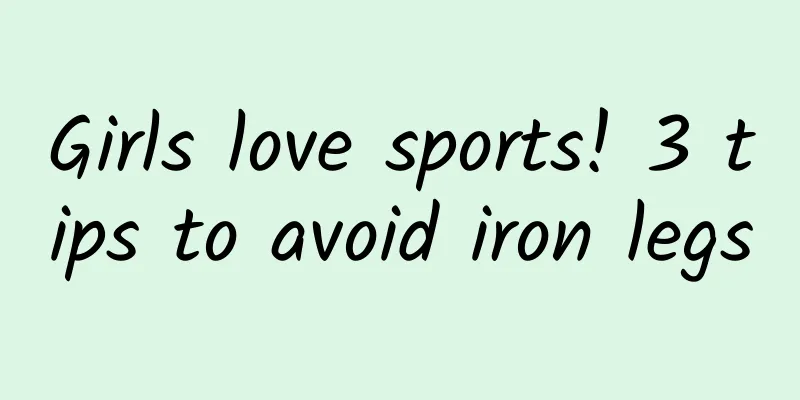Girls love sports! 3 tips to avoid iron legs

|
Sports awareness is on the rise. Taking advantage of after get off work or weekends to go hiking, cycling, and participating in road running activities... these are manifestations of modern girls' love for their own health. However, this may also lead to "small problems" after exercise. The most common symptoms after strenuous exercise are muscle soreness and strain. The former is caused by excessive accumulation of lactic acid (also known as iron legs), which can recover on its own in about 3 to 5 days; strains can last up to 1 to 2 weeks, with fixed pain points, bruising, swelling or fever, and require treatment by a doctor. How to avoid these sports injuries? Here are 3 sports tips that you must know: 1. Extend the warm-up training time Professional physical fitness teacher Vicky Hong said that exercise should be moderate and not excessive. The "24-hour principle" is a very effective self-monitoring method for beginners. If the body soreness and discomfort exceed the tolerable range the day after exercise, it means that the amount of exercise the day before was too much; if there is no soreness the next day, you can consider increasing the amount of training slightly. Only by adhering to a step-by-step approach can you create long-term exercise effects and establish regular exercise habits, and your body will naturally not feel sore due to exercise. If you are going to participate in road running or other sports, you should start preparing for warm-up training two weeks in advance to avoid a sudden increase in the amount of exercise on the day, which will lead to excessive stimulation and soreness in the body. 2. Don’t forget to cool down after intense exercise Do not stop immediately after intense exercise. Instead, reduce the intensity slowly and do some simple, gentle aerobic exercises, such as jogging, walking, yoga, etc. These aerobic activities with low joint stimulation can resynthesize the lactic acid formed in the body into energy and metabolize it, reducing its accumulation in the muscles. For example, after a road run, you can choose to walk or ride a bike home instead of stopping the activity immediately. 3. Secret tips to relieve pain after leg training If your legs are already sore, you should rest more, drink more water, massage more, and do reverse stretching to lengthen the muscles that have shortened during exercise; supplement your diet with more electrolytes (sports drinks), potassium ions (bananas), sugar, vitamin C... all of which can reduce tissue inflammation. Teacher Vicky suggested walking in the swimming pool to reduce excessive contraction of muscles through the buoyancy of water. The water flow resistance generated when walking is equivalent to massaging the muscles. It can calm muscles and reduce inflammation better than water with a lower temperature than body temperature. Other moderate light activities can also increase blood circulation, reduce muscle tightness, and accelerate the elimination of lactic acid. If it is inconvenient to go to the swimming pool, you can also soak your sore feet in hot water at home to relax your muscles, speed up blood circulation in the muscles, and help metabolize waste. ※For more exciting reports, please visit the VOGUE website http://www.vogue.com.tw/ ※This article is authorized by VOGUE magazine and is prohibited from being reproduced without permission. Recommended Reading
|
<<: Beat body fat! 3 sports myths you should know
>>: Watching TV will make you fat! Tragedy with rice, eat 694 more calories
Recommend
Can I eat glutinous rice balls after a miscarriage? It is not advisable to eat too much
After a female friend gets pregnant unexpectedly,...
Precautions and treatment after artificial abortion
After an abortion, you need to pay special attent...
The three major symptoms of uterine fibroids
The symptoms of uterine fibroids are very similar...
Long-term dysmenorrhea may be caused by endometriosis
Endometriosis is a common gynecological disease. ...
Can I do cervical screening if I have ovulation bleeding?
Cervical screening is generally not recommended d...
What are the effects of removing uterine fibroids? How long does it take to get pregnant after removing uterine fibroids?
What are the effects of removing uterine fibroids...
Not just for losing weight! 10 reasons why you and I must continue to exercise and keep fit
Everyone knows that developing a good habit of ex...
There are several reasons why the endometrium is thin. Eating these two things can help you thicken it.
When it comes to the importance of the uterus to ...
Let's learn about the hazards of severe cervical erosion
"What are the hazards of severe cervical ero...
Do cervical polyps require surgery? Generally, surgical treatment
In recent years, the incidence of cervical polyps...
What is the best medicine for uterine fibroids and gallbladder polyps?
Uterine fibroids and gallbladder polyps are some ...
Can’t get rid of lower body fat? Chinese medicine doctor Zhang Wenxin shares 3 secrets to create supermodel legs
Office workers often sit for long periods of time...
Correct exercise method for patients with threatened abortion
Pregnant mothers still only know about resting in...
Is drinking sarsaparilla with salt really effective for treating cold, fever or heat stroke? Professor Wang Jinkun said...
Whether it is to relieve cold symptoms or prevent...
What exactly is candidal vaginitis?
What is candidal vaginitis ? What are the specifi...









